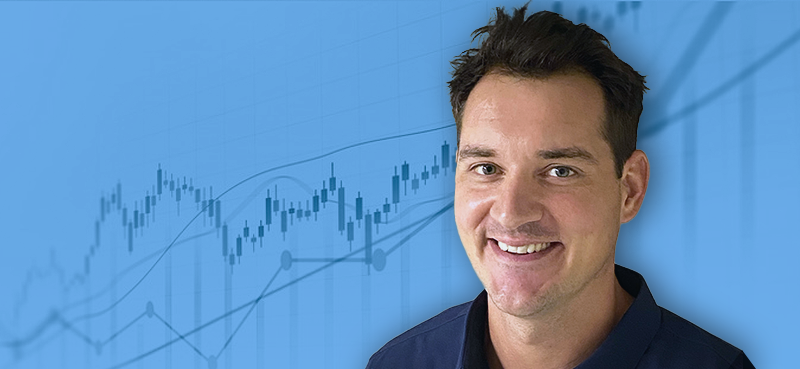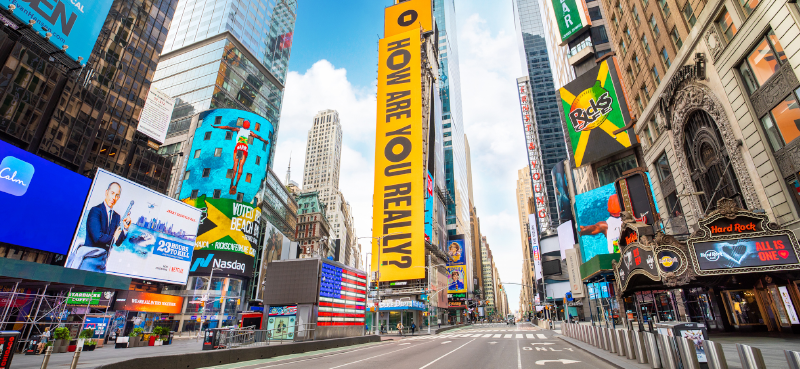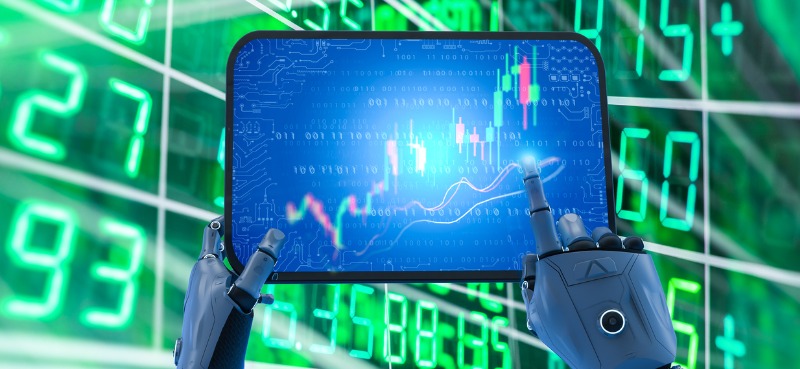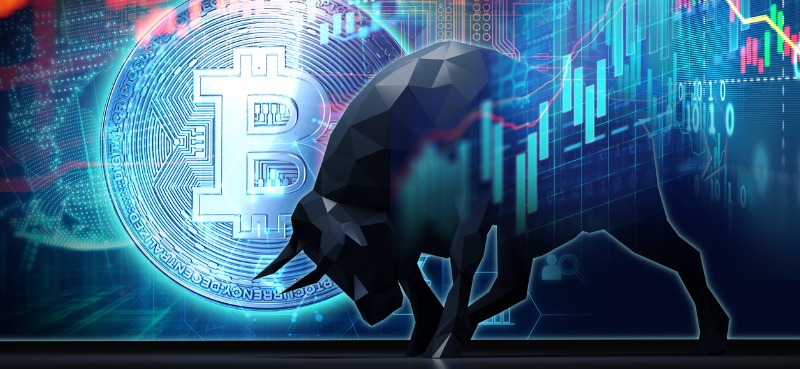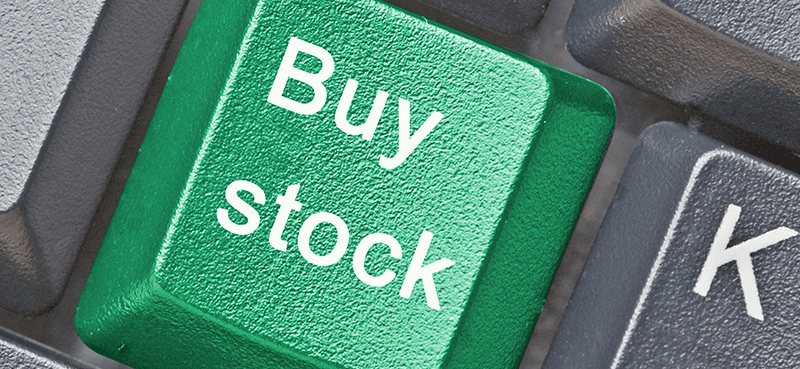Earlier this week, a Fed member suggested hiking interest rates from 2.5% to 4% by the end of the year. Daniel explains why this isn’t feasible without crashing the market…
I go on a rant about the Fed… and why idiotic comments from its members continue to be the biggest risk in the markets.
Turning to earnings: Ford (F) finally seems to be getting its act together… but some of its comments are driving me crazy.
Shares of Paypal (PYPL) surged after its latest earnings report. Daniel breaks down why he’s bullish on the stock—but it has nothing to do with the results.
And finally, I call out popular hedge fund manager Chamath Palihapitiya for taking advantage of SoFi (SOFI) investors… and how to find great companies that have gotten wrecked.
- How the Fed is causing volatility [3:00]
- The Fed is made up of idiots [6:25]
- Convincing evidence inflation is coming down [11:25]
- The Fed could cause the market to fall 25% [13:10]
- Ford is getting its act together [22:50]
- Why Daniel is bullish on PYPL [27:10]
- How a hedge fund manager screwed SOFI investors [32:00]
Wall Street Unplugged | 929
How the Fed’s idiocy could crash the market
Announcer: Wall Street Unplugged looks beyond the regular headlines heard on mainstream financial media to bring you unscripted interviews and breaking commentary direct from Wall Street right to you on main street.
Frank Curzio: How’s it going out there? It’s August 4th. I’m Frank Curzio, host of the Wall Street Unplugged podcast, where I break down the headlines and tell you what’s really moving these markets. So, today’s usually Thursday, interview day, but to be perfectly honest, since I was off, I didn’t set up an interview for this week, just in case I was going to be back a little crazy, which I was, back really, really late. So, I’m bringing in someone who is going to be the best person I’ve ever interviewed in my life, the most best-looking, which is Daniel Creech again, which we’re going to break down the markets. And Daniel Creech is a senior analyst at Curzio Research. What’s going on, man? How’s everything?
Daniel Creech: Wonderful. I like that intro, thank you. I couldn’t find any other interviewer, so boom, I’ll fill the need. No big deal. Fill in Daniel, here we go.
Frank Curzio: There’s no way I was just going to come back and just go through everybody. Again, when I interview someone, you have to realize that I don’t just interview them. I don’t just say, “Okay. Want to come on?” And just ask them questions. I really dig into the research behind these people from the past three, six months, what they’re saying. I’m fascinated. I’m interested, especially if they have different opinions than me. So for me, interviewing someone, I really want to get in the research and make sure that interview goes well, because I owe that to someone for coming on the podcast. And when you have limited time, you have vacations and stuff like that, I’m not just going to throw someone in here and say, “Hey.” I want to make it more timely, I want to educate you. I want to get on a good guest.
Frank Curzio: We got amazing lineup of guests coming up over the next few months, especially through crypto, which you guys are going to be very, very excited about. Really, really good, good, good names. We’re just breaking into that market, and there’s a lot of trust that we’ve earned and gained, and a lot of respect out there, so it’s resulting in a lot of people reaching out to us now in that industry, but for today, we got Daniel. A lot going on. We’re still in the middle of earning season, we’re going crazy here. But before we get to that, and a couple of earnings that people are asking through emails and want to know more about, is what’s your take, Daniel, with the Fed here? Because you have some of the Fed governors coming out, and they’re saying different things here and there, but it’s interesting to see the data come out.
Frank Curzio: And sometimes it comes out a little hot. We saw the last PPI/CPI obviously come out hot, scared everybody, but when we looking at real-time data, you see the numbers. We’re seeing what the Fed’s doing is actually working, but then you’ll have a person like Bullard come out, Fed governor, and just go crazy a little bit. We really need to pay attention to these comments and what the Fed’s going to do, because they lacked the credibility. They were so far behind the curve. They had no idea inflation was coming. They didn’t see, they said 2%. They said it was going to be transitory for now on 24 months, but pretty much 18 months before, they actually said, “Okay, we were wrong,” which you get 11 out of 12 down weeks we had in the market. That’s what happens when the Fed’s on the total wrong side of what’s going on and changes its mind, so that’s got to be the concern going forward. Are they ahead of it? Are they behind it? What’s going on? What are your thoughts about what we’re hearing from these Fed governors?
Daniel Creech: This is tough. Listen, so you’ve got voting members and you got non-voting members, and typically, when headlines come across the ticker and tape and screens and things, they always point that out, at least briefing does, some other things. I hate to say this all the time, but you want to take that with a lot of salt because to your point, that gentleman came out, James Bullard, is that who you mentioned first? Because there’s a couple here.
Frank Curzio: Yep.
Daniel Creech: Earlier in the week, I think it was on Tuesday, Frank, the markets have been up and down, but basically, every time somebody on the Fed speaks, whether they’re voting members or not, they have a lot of influence and it can move markets. And what caught my eye earlier this week, this is from James Bullard, who is a voting member, and this was a couple of days ago, or maybe it was just yesterday, but he said the Fed should get the Fed funds rate we’re talking here to 3.75 to 4%. Now, the current Fed fund rate, Frank, is 2.25 to 2.5.
Frank Curzio: 2.5. Yeah.
Daniel Creech: Now, by the end of the year, excuse me, I left that out, it needs to get from 2.25 to 2.5 is what they’re at now, they need to increase that to 3.75 to 4% by the end of the year. Before I say anything further on how crazy that seems to me, I want to say that last week, Frank, after the Fed raised rates, and Fed Chair Jerome Powell did his Q&A or press conference, he said something that really stood out to me. And he said, “Listen, we hiked interest rates by another 75 basis points at this meeting,” and he says they want to get ahead of this, which they’re way behind on inflation. But he mentioned the fact that the interest rate hikes that they’ve done, Frank, including the most recent one, he admitted and said, “These have not made their way through the economy.”
Daniel Creech: So, we’ve used this analogy before, you think of a spill of some sort, and how long it takes to get down river. Jerome Powell knows that the most recent hikes, and even the previous hike, hasn’t made its way completely through the economy. Now, this gentleman, James Bullard, says that they need to continue hiking. Another member, I think it was a non-member, came out and said they could do 75 basis points again in September, but more likely, it’ll be 50 or maybe even 25. If these former Fed members and existing Fed members are even close, Frank, the market is not pricing in a 4% by the end of the year, in my opinion, and you would see a massive drop in a retesting of the lows earlier. The aggravating thing here is you don’t really know. Powell took off his guiding light.
Daniel Creech: He basically said he wasn’t going to be as transparent going forward and try to steer the market as to what he’s going to do, so my thesis or my thinking has changed a little bit in just the last week, Frank. These guys drive me nuts because they’ve tried to hint at maybe a slowdown in rate hikes, but these guys are saying the exact opposite. And just about when everybody’s starting to get bullish, this is either going to be a great head fake or a great bull market, or a great bounce in a bear market. But honestly, this is very aggravating. I wish these guys wouldn’t talk, and when I say these guys, men and women in the Fed, the members. I wish they wouldn’t talk near as much as they do, because they’re just keeping the unknowns alive and well, Frank. It drives me crazy. And remember, they’re not meeting in August, because why? Because they’re lazy, and they’re taking the month off.
Frank Curzio: I have to say, I’ve been on this podcast saying these are supposed to be the smartest guys in the room, and everyone who pays their bills in America or even in the world knew that inflation was horrible and getting worse, and prices were being raised, and they saw it in their bills. But the Fed said it’s going to be transitory because they looked at a lot of shit they looked at in the past 80 years, 100 years, and they go back with all these models, yet they never had a model where $11 trillion was printed and handed to us through Fed monetary fiscal policy. And this money was not given to the banks like the last time, that’s why we didn’t really see inflation, because the banks were bailed out. They got the money, they chose who to lend and whatever, and they had more rules. And a lot of them had still have a lot of cash in a balance sheet.
Frank Curzio: We all know what happened then. The Fed did great in their investments, the government did great in their investments, in terms of buying warrants and stuff like that during the credit crisis. They made money on everything, which was terrible, so they feel like they could bail out everything now and everything will be okay. So going into that playbook, which again, they don’t know how to forecast in the future. I’m going to say this, and I don’t like saying this, but it’s true, but they’re idiots. I usually think they were a lot smarter than they were, but when I look at the Fed today, there’s a reason why they’re economists, because they can’t make it as analysts, which their salary would increase by 20X to 30X.
Frank Curzio: So, whenever they’re forecasting, they don’t understand how the economy translates into stocks, and they don’t understand how people react to certain things. That’s how you forecast. You have to understand people. You have to understand spending patterns, and only spending patterns they look at is lagging data, and then they compare it to the past and use models from the past, using models that are outdated. You’re reading books that make no sense because this is a total different market. You didn’t just hand this money to the banks, you handed it directly to people. You bypassed the whole entire economy. You just handed them checks. Everybody getting checks, checks, checks, check checks. You’re still getting them, you’re still seeing them with Manchin, and you looks like they going to pass even more of spending bill. So they keep spending. They keep spending, spending, spending, and now you’re seeing what is happening.
Frank Curzio: When everything got back to normal, you still decided to spend like crazy. About 40% of that $11 trillion in spending came after January, 2021, when earnings started hitting record highs again. Home price, record highs, almost all asset class were at record highs, and you still kept pedal to the meta, and now you’re seeing mass inflation, so you guys are dead wrong. Now you’re listening to what these guys are saying. This is the biggest risk to the market. By far, this is the biggest risk because we saw when the Fed is caught off size, what happens? The whole entire market readjusts. 11 out of 12 down weeks, something we’ve never seen in history. That’s how bad it was, because it was so wrong on inflation. They said 2%, 8, 9%. That’s massive. That’s massive. That’s massive. That’s massive, massive.
Frank Curzio: I can’t even explain it. I can’t even use an analogy to say how bad that is on a forecast. That’s like forecasting a team’s going to win 1-0, they lose 87 to nothing. That’s how bad that forecast is. So Dan, let’s get to what some of these guys are saying, which you need to shut them up, because they don’t know better. Like Tom Barkin, Richmond Fed president, non-voting member, shut up, please. Please, shut up. Just go back in your hiding spot. Go into your room and look at charts and figures. Just shut up and stop making public comments, because he says, “We’re committed to returning inflation to our 2% target, and made it clear we’re going to do whatever it takes.” Cleveland Fed president Loretta Mester, please, you need to shut up, says inflation’s not going to come down quickly. She’s seeing little signs of progress on inflation, says we must see convincing evidence that inflation’s coming down before stopping those rate hikes.
Frank Curzio: San Francisco Fed president Mary Daley, another one that needs to shut up. Nowhere near almost does, says inflation is far too high. And then we have James Bullard, St. Louis Fed president been around for a while. Before I get to what he’s saying now, let’s go back through a little history, Daniel. Sorry I’m taking a little long on this, but we have to go back. In June, 2021, this guy said he sees core inflation will be 2.5% in 2022. We’re at 9%. He revised that in November, said, “Oh wait, November, we’re only going to see two rate hikes in 2022,” which means 25 basis point rate hikes in 2022. We just went 75, 75 the last two. Then in January, he’s like, “Holy shit, I was so wrong on this.” He goes, “We’re going to have four rate hikes now in 2022.” Again, wrong.
Frank Curzio: Now what is he saying? Totally on the other side of the spectrum, which is good news, which is really good news. If you’re following this guy and do everything opposite of what he says, you’re going to make an absolute fortune. He says we need to go to 4%. Soft lane is possible, but Fed still needs to keep raising or hiking rates. He says he supports front loading rate hikes, Fed still has some ways to go to get to restricted policy. He says the Fed should get to rates at 3.75 to 4% by year-end. By year-end. We’re at 2.5. We’re expecting a 50 base point hike right now that’s just pricing in for September. So, he’s saying 4% by year end. Same thing, what Mary Daley said , what Loretta Mester said, and what Tom Barkin said. All these idiots said the same thing, Daniel. We need to see convincing evidence of inflation coming down before the Fed is satisfied that it’s doing your job. Since you guys, I’m sorry, all right-
Daniel Creech: Say Florida, don’t say the other word.
Frank Curzio: No, no, no. I won’t say the F word, but since you guys are such idiots and don’t understand the markets, I’m going to explain them to you. And yes, that sounds arrogant, but they need this. So, you don’t have convincing evidence. That’s what they’re saying, and they’re saying this, this is the past couple days they all came out with this. While I’m on vacation, I got to see this. This is what pisses me off, Daniel. So, you need convincing evidence. How about oil down 30%, gasoline prices down 25%. How about copper prices down 40% from its highs? How about lumber down 50% in three months? How about the declines of wheat, fertilizer, and corn that we just said, which we saw? How about retail numbers out of Target, Walmart, Kohl’s, Macy’s, Beth, Beth, and Beyond, almost all those retailers where inventory levels are 35% higher than normal, and they all said it’s going to take many months to work off this inventory, which means cheaper prices?
Frank Curzio: Supply chains are easing. We’re seeing that across the board. This is data I’ve been reporting to you that we have access to. For 25 years, people have been following it. I told you why Ford and GM and all the auto manufacturer were lying out their teeth, saying that this is going to end 24 months ago, 18 months ago, six months ago. Now, you’re finally seeing it ease. You’re even seeing it for numbers, which will cover in a second. So, you’re seeing the supply chains ease. Why? Because you’re seeing demand come down. Demand is cooling, so it’s a lot easier. Big decline in used vehicle prices is the last numbers. How about housing? Mortgage demand falling to its lowest level, Dan, since 2000, so what does that mean? Think about that.
Frank Curzio: So, fewer people are going to be buying houses, which means they’re not going to be buying appliances, paint, lumber, sheet rock, materials, everything that goes into a new house, or even if you’re moving. Or what about the consumers, the things that they purchase like furniture, carpets, paintings, lawnmowers, all this stuff? This impacts all this, but they’re not seeing it. I’m quoting here, the Fed needs to see convincing evidence of inflation coming down before the Fed is satisfying that it’s doing its job. I can’t even talk because I’m so pissed. So that’s what they’re saying, that they need to see evidence, like this isn’t evidence. I’m not saying that we’re done, but there’s evidence showing that what you have right now is obviously working, and it’s going to get progressively tougher than market conditions. And it’s working right now at 2.5% interest rates, and you want to bring them to 4, and you’re admitting that this is a lagging indicator, and it takes a while?
Frank Curzio: If you bring them to four, we’re overvalued by 25% on the S&P 500 if you bring this to four. The market’s going to come down another 25% from here if you bring them to four. You need to go up a half point in September, analyze the data. September’s going to be ugly. You’re going to see all these numbers coming down tremendously. You’re seeing it right now. You might not see it in food a little bit longer. Yes, we want gasoline price to come down, but now what are they, $3.80, $3.70 here? I’m seeing $3.80, I paid last night. They were $5.00 here, and it’s a big difference. They were $3.00, they’re still high, but you’re you seeing it solely going the right direction. So, the moderation is that you’re seeing that. How about the recent survey CNBC just took with SurveyMonkey? It was a small business survey.
Frank Curzio: 77% think inflation is still going to rise, 75% say inflation will have a negative impact on their businesses, and 57%, so close to 60%, think we’re in the recession. All those three things say that small businesses are cutting back spending dramatically, if that’s what they really believe. We’re seeing tons and tons and tons of evidence. For you to say we still need to see evidence is insane. It means that these guys have no idea what they are doing, Daniel. No idea what they’re doing. That’s the biggest risk to the market right now. It’s the Fed, it’s rates, and they’re going to go way, way too far in this. You’re seeing this work. You got to get out there. You’re seeing it.
Frank Curzio: If you get out there and get out of your little circles with all your little rich people, and all of them pull up in the Ferrari and stuff, and your little freaking thing, you got to see Main Street, America. Middle class America, they’re starting to struggle. You’re seeing it. They have money to spend, it’s not horrible, but you’re seeing the decline almost… I don’t want to say in everything, but you’re seeing it hurt so many people out there. You’re seeing the declines, you’re seeing how interest rates impact the markets. It’s going to get worse than 2.5%. I understand if you bring the 3%, you’re talking 3.75, 4%, you absolutely have no clue what’s going on, which is evidence based on the track record.
Frank Curzio: So, the good news is that Bullard has been wrong almost his whole freaking career. It’s great that he was wrong because he was really, really wrong saying, “We’re not going to need raid hikes. Now, he’s going crazy. The contrarian indicator is James Bullard. Right now you should be buying stocks because at 4%, he’s absolutely out of his mind, and all these Fed governors are absolutely out of their mind. They’re not doing their job. They’re not seeing what’s going on out there, which is sad because their job is to follow constituents and listen to them. If you listened to them, you would see these stats that I just said, and they haven’t. Sorry to go on so long about that.
Daniel Creech: No, I like that. I’m going to play devil’s advocate just one second here, because what he’s referring to in the sense of we got to see meaningful inflation come down, I believe he’s talking about on the readings. So the CPI, the consumer price index, next reading for this month… Excuse me, we’re in August now. Time flies… July comes out August 10th, I believe. That was just a quick search. So, that’s next week, right? Today’s the fourth. All my days are run together, Frank. Anyway, we’ll get to see that CPI. If that’s above the 9.2% that we sold last week month, then this guy, you can give him some salt. However, just as you pointed out, is there any way that it prints higher than that with what’s going on? There’s no-
Frank Curzio: It could print higher. You know why?
Daniel Creech: Rental.
Frank Curzio: Because here’s what the Fed did.
Daniel Creech: Rent income?
Frank Curzio: Rent. Rentals account for 40% of CPI, and rent is still moving higher. So, what the Fed has done over the past 25 years, and I’ve done research on this, they revised this index so many times to make sure that it almost never shows inflation. They’ve revised it so many times, it’s a totally different method of calculating compared to the eighties with inflation. If you use the same method as inflation as in the eighties, we would be much, much higher than the eighties. It would be the highest inflation we’ve ever seen. However, they’ve always made it, just like the Fed always…
Frank Curzio: Listen, remember when it was unemployment rate? We need to see the unemployment rate go below 4%. We need to see it go below 4%. It went below 4%, and how do they justify keeping rates at zero? Oh, well, we’re going to look at the inflation rate now, and the inflation rate’s under 2%. And since it’s been on the 2% for such a long time, it’s not going to go higher, so we can keep them low. It’s a little bit above 2.5%, that’s okay, and 3%, that’s okay. So, they just keep changing as they go, just like-
Daniel Creech: Moving the goalpost. That’s what you do.
Frank Curzio: But Dan, remember when a recession, how does the whole entire world to define a recession? To cause negative GDP growth. You see it, and they actually play this, and you can see a million people mention this in the media. We get it, “No, no, no, no, no, no, no. This isn’t a real recession because unemployment’s still good,” even though you’re seeing not everyone, but so many companies laying off employees now. So many companies laying off employees, you’re seeing the data even in real time. Wait until you see unemployment data. It’s going to be horrible over the next three, four months.
Daniel Creech: And when you say that, sorry to interrupt, everybody from Robinhood exchanges, they’re cutting people like crazy-
Frank Curzio: Technology companies across the board-
Daniel Creech: To Oracle, to everybody else. Yeah. To your point.
Frank Curzio: Microsoft’s slowing, you see Google slowing, Apple’s slowing. Some of these are actually cutting, but just across the board, you’re seeing it. You’re seeing it in a lot of industries. For these guys not to see this and understand the markets from our point of view, when I say our point of view, I’m talking about everyone that listens to this, everybody has a job, everybody that pays their bills, it’s a joke. You’re seeing prices come down. We need for them to come down. Remember, we need moderation. This way, the Fed says, “Okay, we’re going to slow.” They’re not talking about slowing, they’re talking about getting super, super aggressive, even more aggressive. If they do, if they really go to 4%, especially by the end of this year, which is insane, if they do, you’re going to see the mark come down dramatically from here.
Frank Curzio: We have to stop at 3%, at least 3%, and analyze the data. If we’re seeing inflation pick up after that, which we’re going to see in everything that I just mentioned. We’ve seen copper prices take off, lumbar price take off, oil and gas take off, it’s different. But as of right now, you’re seeing most of these things come down in price, and they’re going to continue to come down in price, and not all of a sudden just going to go higher, especially with higher interest rates. So, for these guys to be that far out there and not understand this, and allow these guys to speak publicly is a joke. We need one guy to speak, Powell. That’s it lot. Lock these guys in a closet. They go into meetings, nobody cares, seriously, but they’re able to move the markets now. But the fact that they get so much press coverage, and again, a lot of these guys, they all have to be popular, and me, me, me, me.
Frank Curzio: That’s the whole social media generation. Me, me, me, me, me, look at me, look at me. 10 years ago, no one knew any of the Fed, and now you know every one of them because they’re all talking out and speaking at conferences, and saying what they think, and it’s totally different from what Powell is saying sometimes. So just keep these guys locked up in a closet, put a muzzle on them, because they have absolutely no clue what they’re talking about. We’ve seen that for many, many years, many years these guys, but this just frustrates the hell out of me. I didn’t want to go that long on this, but man, come on. We are seeing some signs, but if you look at the CPI data, with rent accounting for 40%, yes, it’s going to be high. But if you’re looking at almost all the other components-
Daniel Creech: Exactly.
Frank Curzio: That’s what’s important. That’s real America.
Daniel Creech: Mark your calendars, people. August 10th will be interesting.
Frank Curzio: Yeah. It will be interesting to see, and hopefully, they’re not using that because there’s just so many gauges showing that moderation. And again, these are all facts I’m saying. I’m not just saying this is opinion, these are all numbers that I track that. We were saying inflation is going to go through the roof, the Fed is a bunch of idiots that have no idea what they’re talking about. We’ve been saying this for 24 months, 18 months, so we even adjusted our portfolios to say wow, there’s a fundamental difference in November. This is a massive change, and the Fed’s not going to be there for you anymore. We’ve even lightened up on some of our positions. Granted, we’ve had losers and we’ve been wrong, Daniel, and we always say when we’re wrong.
Frank Curzio: But with this, just being able to see this come and where we are right now as inflation’s moderating, and the Fed, they want to go even further, it just shows how out of touch they are with America, and it’s very, very sad because you’re about to really destroy, really destroy our economy if you’re going to 4%. They have no idea what that’s going to do. For you to even say that number, you’re out of your fucking mind to say that. Sorry. You’re out of your mind to say 4% by the end of the year. You are out of your mind. You’ve probably been on vacation for five months and just came back, and have no idea what’s going on, and maybe looked at a CPI reading.
Frank Curzio: For you to say 4% right now, and you’re supposed to be one of the smartest people in the room, you’re absolutely out of your mind. We can’t go to 4% with the current data of what we’re seeing. Maybe we have to go to 4% if we see gasoline prices go to $5, $6, if we see all prices go to $150 again, if we see fertilizer prices and food price, that’s different. The data right now suggests we should be no higher than 3%, and hopefully, the Fed does its job because if they do, this is a soft landing. Maybe we come back and test those a little bit here and there, but you’re going to see some buying come back into this market finally, if they get this just halfway right. 4% is 0% right.
Daniel Creech: 0% right. Oh, that’s awesome. Well, we’ll see, because like I said, we got the August 10th number and then the meeting in September. Depending on that data, they’ll see about a 50 basis point or whatever. I’m with you. I just think if they get to four by the end of the year, or even Powell hints at that, I think you’re right, stocks are going to go way down. Longer term and the permeable ME, which I hate using that term, is that’ll go do a lot for opportunities.
Daniel Creech: That’ll bring a lot of good, quality stocks down, like we’ve talked about earlier this week. However, that’s why it’s okay to have some cash on the sidelines and be nimble, because you have to deal. This is the risk, like you said, and investors, you got to pay attention to this. Leave it to us. Don’t go crazy. We can laugh about it and go crazy here, and rant, that helps. But it’s just something we have to pay attention to, unfortunately, Frank.
Frank Curzio: Yeah. And I do want to break down some earnings here, as we got seven, eight minutes left. Let’s start with Ford. I had a little rant there, but Ford, I’m back. I feel like I got to rant a little bit, just seeing some of this stuff. But Ford reported very strong sales for July. Good for them. The stock had been negative on. The fact that Ford actually came out and said, “We’re spending %50 billion on initiatives in EV, and we can’t make money on EVs right now,” I thought that was very interesting. “I’m spending $50 billion, but we can’t make money on the product that we’re building, at least for now.” Maybe prices become cheaper, maybe they get more money from the government. However, this company, in order to fund that, they have to sell more gas vehicles and trucks.
Frank Curzio: That’s what you saw this month. Good job. You can go into EVs and still sell gas cars, which you see 98% on the road right now. You need to do that, because you do have the 4 to 450, so amazing sales. Of course, a percentage increase in EV sales that they mentioned, that’s going to always go higher and higher because they’re coming off of such a small, tiny basis of a few 1,000 cars. But you saw the F-150 sales surge, but they got to stop talking about, EVs like the gas market’s done and it’s over with, and these gas vehicles are done. We know the EV market is coming, but it’s still very expensive, we’re seeing supply chain concerns. There’s not a lot of deliveries. Now you’re going through pretty much a recession now, so people are going to cut back all the $100 and $200 they put down on a new car. They’re probably not going to buy those new cars now. Some of them, at least.
Frank Curzio: Some of them knew that their portfolio is down 30% from their highs, and maybe they lost their jobs or whatever. But Ford, good numbers at 15. 25 I hate the stock, 15 I wouldn’t be buying it. Maybe I wait for it to come a little lower. They are going to have, again, those sales are up. We have to see supply chain concerns, inventory concerns and things like that, which they’re still going to go through, but it’s nice to see. This beat was because of sales of gas vehicles. They need to really push that issue. Produce more of those while going in your EV initiative, stop talking about one and not the other, because that’s what’s going to fund the EV initiative.
Frank Curzio: And Ford needs to do that, but now you’re seeing them actually get the mix right, which is cool. So, let’s see. It’s early. I didn’t like Ford for a while, but let’s see how the report next couple of quarters, because I don’t know if those sales are going to be strong during times when we’re seeing higher interest rates. Not as easy to finance, and maybe people won’t be paying up for cars or really nice cars because of recessionary conditions or people that are really worried about what’s going to happen in the future. So, Ford was pretty good.
Daniel Creech: Well, hey, let’s hope that the used car market and all that pay up doesn’t stop yet. I’m thinking about trading my truck in, Frank. I have a Ford truck, by the way, and I like it. I just don’t need a truck here. Anyway, I want the used car market to stay elevated for a little while.
Frank Curzio: Yeah. It’s coming down, though. These car prices are coming down.
Daniel Creech: I’m probably stuck with it, but that’s okay.
Frank Curzio: Again, the down a little bit compared to how high they went.
Daniel Creech: Exactly.
Frank Curzio: We know that, but we really need to see it-
Daniel Creech: It’s like gas. Hey, gas is down. It’s not $5 anymore. Well hell no, it’s only $4.
Frank Curzio: And please, I’m not saying that to say, “Well, we’re fine.” No, we need to come down further. But from the Fed point of view, if you’re looking at stocks, you want to see when the Fed’s going to stop and when they may cut these rates, which I think is going to happen a lot sooner than most people believe because we’re seen to decline a lot of things, and that’s what you have to focus on, because that’s why you’re seeing a little bit of a bounce now, a little bit of a bounce. And then we have PayPal report, which it’s funny because this is a 46% from its June entry day lows, and went up 9% yesterday, but that’s down 50%+ from its highs. This is a solid name that’s just saw a decline in growth, more competition, but yet, had Elliot Management come and take a $2 billion stake.
Frank Curzio: Look, they lowered their revenue outlook. It’s still $27 billion. They announced a $15 billion buyback, but PayPal looks like it should form a bottom. I don’t see it fall into those levels where it was, where everybody got out, but that’s where we are on some stocks, where just everybody’s out. We know the inflation, everybody’s concerns. This is why we got bullish pretty much a month and a half ago in all of our newsletters, two months ago listen to the podcast and saying, “I’m picking away here. I’m buying, I’m aggressively buying here.”
Frank Curzio: And the market came down a little bit after I said that and after we said that, but just the levels that some of these stocks that are trading, even in biotech, trading at cash levels with good biotech names, not phase I, phase II, companies that have generating revenue of their products. There’s just so many names that looked attractive if you have a 12- to 24-month outlook, if you like stocks and these things are down, getting a chance to buy some of these names on 30, 40%, that much of a discount. And some of those outlooks declined a little bit, but not that much, and now, you’re seeing a company like PayPal at 50% from its highs, which is pretty cool.
Daniel Creech: Yeah. I don’t follow PayPal a whole lot. I’ve never used it. I am interested in this, and this is going to be risky, Frank, and you can get me back into shape here because seeing a stock, am I worried about PayPal going to zero? No. I think the business has got sticky customers, it moves a lot of volume, that’s all good. When a stock like that you’re not worried about going under drops 50%, A, something should go off, and you should at least be interested looking at it. B, and this is the risky part and the young analyst in me here, Frank, Elliot Management is one of the most successful, cutthroat, amazing hedge funds ever. And one of the differences between them and a lot of other people is they are successful globally.
Daniel Creech: And I don’t mean this in a negative sense, and I know this sounds like a know it all, it’s one thing to be a successful hedge fund manager at home. When you can do that in America or Europe or anywhere else, that’s impressive to me. The risky part of this, Frank, you can yell at me and just don’t fire me, we can timestamp this and have some fun, I would follow Elliot Management into this a little bit blindly. This is worth buying a little bit here, just because Elliot Management is not going to stick around and let them do whatever it is they’re doing right now. There’s going to be some serious changes made, or rumors and headlines of changes coming, and I think that’ll move the stock higher over time.
Daniel Creech: Of course, if they liquidate or get upset, but it was a $2 billion stake in the company. I don’t know how that gets them into inside ownership, but just another fun fact, a lot of companies ought to be paying attention and figuring out hey, we want our share structure tight enough to where somebody just can’t come in when we drop like this for market conditions and kick us out and everything. But Elliot Management doesn’t give a flying flora about anybody at PayPal, and they will replace everybody. I think of Elliot Management like Charles Barkley. Did you get his comments or hear his comments about maybe joining LIV?
Frank Curzio: Yeah. It was amazing.
Daniel Creech: He talks about somebody giving Phil $200 million, and I’m paraphrasing, but he said, “Hell, for $100 million I’d kill a family member, for $200 I’d kill one I liked.
Frank Curzio: But he said how the Saudis are actually funding the woman’s tour, the largest sponsor on the woman’s tour. Did you see that? So, he is like how come no one’s saying anything about that-
Daniel Creech: No, I was laughing too hard, I couldn’t hear anything else.
Frank Curzio: I’ve been vocal about that. It’s just the spending from the PGA in terms of lobbying to get the message out how bad this is to keep their monopoly is very sad. Plus, if the tour sucks, it sucks. That’s a different conversation we’ll get into. I did want to talk a little bit more about PayPal, but I did see those comments.
Daniel Creech: Anyway, the Elliot Management thing, that’s brilliant. And if they see something there, it’s definitely worth individual investors digging into, or at least following them because they’re going to make some things happen, and I believe that’ll result in a higher share price.
Frank Curzio: Yeah. And I agree, but just you’re looking at this company who’s $300 on the $100. At $300, you’re looking at this market cap above $350, $360 billion. Now, to put that in perspective guys, because we’re so used to seeing the $1 trillion market caps for the majors, you look at Walmart, this company had a bigger market cap than Walmart than Procter & Gamble, than MasterCard. It was the 14th, 15th largest company in the US based on market cap. That’s how big PayPal was. So, you’re seeing competition, you’re seeing market share, they’re still doing $20 billion in sales, but just to show you how big this company is and how much it pulled back, they still have big market share, but it’s nice to see Elliot Management in there.
Frank Curzio: These guys are activists investors and keep them on their toes, and they probably welcome the news because the stock was just getting hammered every single way. I’ve seen so many value and growth people jump into this thing all the way at $300 to $250, $200, $150. This thing, what was the low here? It went from $300 to $67, so $70. It’s off its highs, it’s closing on $100 now, but it’s just interesting. By the way, you’re looking at it as PE, which is important, because you’re like, “The stock’s down so much. It’s cheap,” PayPal’s not cheap. It’s 25 times forward earnings. So, that’s why you’re seeing technology stocks still get crushed, where people are like, “Wow, they’re down so much. How can they?”
Frank Curzio: They get down to a level where AMD at 18, 19 makes sense. They get down to where Google, you look at Apple, under 20 times forward earnings makes sense with their growth. But the days of 30, 40 times forward earnings, the Snowflakes and things like that, and 60, 70 times forward earnings, those days are over. Those days are going to be over for a while with higher interest rates, so you’ve got to find growth, but not to the point where a lot of these stocks, if you’re sitting on something trading at 40 times forward earnings, look out because all they have to do is barely beat those estimates. They have to blow away the estimates. If they meet those estimates, that stock’s falling 20, 30%. We’re seeing that right now with Snap.
Frank Curzio: How do you print out, is it Pinterest or Pinterest, whatever it was? That stock got murdered before, again, Elliot Management I think took a stake in that one too, and it had a good quarter finally, but a lot of these names have gotten absolutely annihilated. And one name I wanted to mention is SoFi. SoFi is one of the Chamath Palihapitiya products that he made a fortune on during the SPAC boom, credit to him. You could pat him on the back and say that’s great. He’s brilliant, or you could say he’s a little fucked up because he wrecked every individual investor and retail investor’s promise, just like he did with Virgin Galactic with his SPAC, merging with Richard Branson, saying, “Oh, we’re going go into space and everything’s great,” and again, you destroyed all these poor people that went in it, which is fine. You made the money and that’s capitalism. That’s fine.
Frank Curzio: SoFi’s a good example. This stock went from 25 to 4. It went up 30% yesterday, obviously short selling. A lot of shorts on it, but it was at four. I want to explain this to you, because you’re looking for ideas. A good idea is to look for some of these SPACs and some of these companies that IPOed during the boom before November, pre November 2021. These names are down 80%, some down even 90%, trading at levels that are insane, and deservedly so because they came out with crazy evaluations, Daniel. But when you’re looking at these, the SoFi numbers were okay, but in May 21 with the SPAC, they raised $2.5 billion in cash, in cash, to SPAC. Put them at an $8.5 billion valuation. The valuation for the 30% move was below $5 billion.
Frank Curzio: So, a lot of these names have a ton of cash on their balance sheets. Yes. Growth is slow, but these guys are growing 40, 50%, 70%. Now they’re growing 15, 20%, which is still two, three times to market. Now, they’re down 85%, 90%, they’re getting lean. They’re cutting costs, they’re cutting employees, sitting on this massive cash balance, and they come to these levels where it makes a lot of sense to buy some of these names. Start looking. It’s the easiest way to probably capture 50% in a couple of weeks. I’m not going to say there’s little downside, because there’s downside to everything, but a lot of these names have priced in down 80%+ because they came out at ridiculous valuations, which is their job to do because retail would just buy anything.
Frank Curzio: You need the retail market out there to buy all the shit, otherwise SPACs don’t work. That’s the reason why they didn’t work, and now they came back because they were able to sell it to the retail investors and get everyone in early, and sell it to retail investors, so they get wrecked. That’s a SPAC model. But you’re looking at SoFi with their technology, where the younger audience, millennials, millennials are 40 years old, guys, these are millennials now, this is a massive market. They have financial products, provide a little bit more interest, which is usually red flag, probably the reason why it came down a little bit. Personal loans, credit cards, all these banking services through mobile apps and desktop interfaces and things like that. So just online digital, this is a name that’s taking market share away from PayPal.
Frank Curzio: So, you look at some of these names, they are good companies, they just came out at super valuations because they were able to sell those valuations, and a lot of these guys who were in these stocks were able to sell two, three, four months later. That’s the lock up periods for SPACs. They’re already publicly traded vehicles. Remember, for private companies guys, the liquidity period in a private company is seven to 10 years. So, liquidity period means the time you’re able to either sell through an IPO or if it gets taken over, seven to 10 years, if you get to that point. A lot of small caps don’t, which SPACs are really public traded vehicles.
Frank Curzio: These guys can sell in four months, get out and get into next situation, which Chamath did in three, four, five of these things, and made a fortune. Now, again, you might be able to pick up the pieces here, because these are names that are good companies now that are trading at much cheaper valuations, down tremendously off their highs, but SoFi was $18 billion company in October, 2021. It’s $billion now, and they have $2.5 in cash that they raised, and this is going to be a company that’s going to be lean going in. Start looking at these names. I know they’re crappy, they’re down tremendously. Have fresh eyes on them, forget about the past, what happened.
Frank Curzio: You could see it, but you’re going to see these companies have a ton of cash, they’re lean, and they’re still growing faster than the market. What makes them strong buys, once the Fed says we’re slowing down, which I think they’re going to say in September, and they hinted a little bit at this current meeting saying what we’re seeing is working. Forget Bullock and the other idiots, what we just talked about. But we could see that. I was just interested to bring that up with SoFi up so much. A lot of that is short covering, but it’s nice to see that move because a lot of those names we’re looking at right now might make their way into our aggressive portfolios.
Daniel Creech: And to your point, you want to see some results trending in the right direction after getting smacked like that, or wrecked. And to your point, the couple numbers that get my attention to dig further into this, and it would’ve been a great trade going in, individual investors pay attention, especially during the volatile times and earning season, hell, pay attention to the high short interest. We talked about Camping World the other day, et cetera. But for SoFi, adjusted earnings before interest, taxes and depreciation, in 2019, Frank, the actual result was negative $148 million.
Daniel Creech: 2020, it was a negative $45. 2021, it went positive to $30. Now they’re projecting for 2022 to be between $105 and $109 million. That’s a little bit of an increase. My point is that the stock price is uncontrolled by the managers. You can’t dictate what the market’s going to do. However, when your stock gets hit, if you have a strong balance sheet, you have a lot of cash, like you mentioned, and your results are actually trending in the right direction, that’s at least reason to dig further into and set up for a good opportunity to go along.
Frank Curzio: Yeah. And when I’m looking at these technology companies too, even ROBLOX, another one that went down from $140 to $20, this is a name that generates $2 billion in sales, just millions of users. You see a lot of the companies go to these guys to build a metaverse around it, even though it’s not truly an open metaverse, from ROBLOX, but they have the technology. And by the way, ROBLOX want to become more open, which is cool. I don’t think that’s going to be capable for a Fortnite. The Epic guys said it as well. The CEO, we’re trying to get an interview with him as well, because the excitement around the metaverse for him is just incredible, but he wants it to be open and not closed, meaning that all the profits don’t funnel into your company. You’re giving developers free access to create whatever they want to create, and you just see this enormous growth. You’re unleashing creativity and innovation.
Frank Curzio: But when you look at some of these names, where they go down to five times sales, six times sales, when they’re trading 30, 40, 50 time sales, now you’re talking about companies that really make sense here. A lot of technology companies are starting to come down to levels that make sense, but you have to be careful because some are still expensive, but I would definitely look at the SoFis. I would look at some of these names that came out through SPACs, pretty much I would say ’20, almost all through 2021, into November and December, before the Fed did that about face.
Frank Curzio: And you’re going to see these names down 70, 80%, but their balance sheets are much, much stronger. They’re trading at 70% plus discounts from where they were when they first came out, and a lot of them look good fundamentally, which is crazy saying because they looked horribly fundamentally when they first came out, but that’s what we’re looking as well. Any final thoughts, Daniel? We covered a lot there with the Fed and different earnings. We’re going to continue to cover earnings in these podcasts. We love earning season, and hopefully, we’ll get some great ideas to you guys.
Daniel Creech: A lot of good stuff and moving pieces out there, so a lot of fun here.
Frank Curzio: All right. Really cool stuff. Thanks, Dan, for coming by. So, that’s it for me. Questions, comments, I’m here for you at frank@curzioresearch.com. Daniel?
Daniel Creech: daniel@curzioresearch.com.
Frank Curzio: Very good. Really appreciate all the support, and guys, I will see you next week. However, if you subscribe to any of our products, I’ll see you tomorrow. Frankly Speaking, which only goes out to paid subscribers through our website and gets directly sent to you, that’s a podcast where it’s a Q&A, any questions. I’m back here, keep them coming, frank@curzioresearch.com, put Frankly Speaking in the title because I get lots of emails these days, this way I could pull some of them, and I’ll answer the questions that you guys have. Other than that, I’ll see you guys tomorrow. Take care.
Announcer: Wall Street Unplugged is produced by Curzio Research, one of the most respected financial media companies in the industry. The information presented on Wall Street Unplugged is the opinion of its host and guests. You should not base your investment decision solely on this broadcast. Remember, it’s your money and your responsibility.
Editor’s note:
After driving inflation through the roof, the White House is now determined to redefine the word “recession”… and that’s just the beginning of the corruption at the heart of our financial system.
Go here to listen to Frank’s most controversial rant ever—and learn how investors can turn government idiocy to their advantage.


